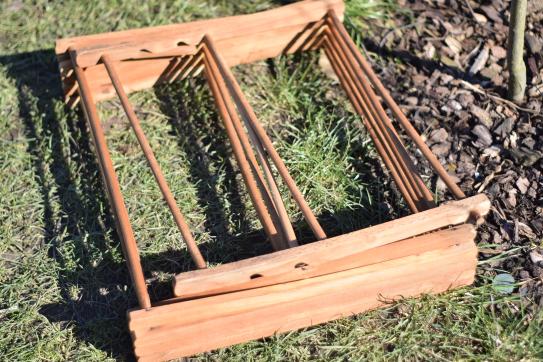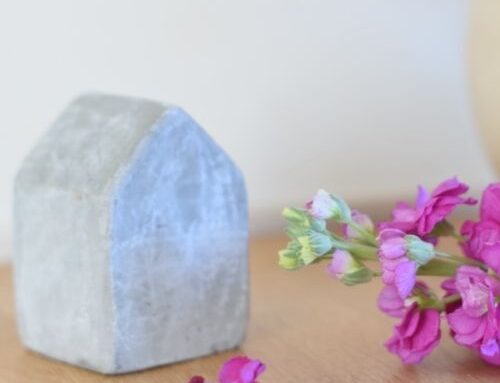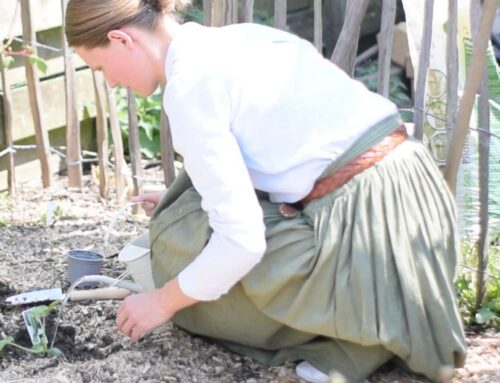Written by: Tahnee Wientjes
Start saving on energy costs and enjoy the freshness of outdoor air, join me as we explore the simple joys and practical tips of line-drying laundry.
Table of Contents
Why dry on an outdoor clothesline?
We’ve had a clothes dryer on and off for the last few years. We didn’t have an electric dryer for a while when we had 4 children. Certainly, laundry was (and is!) an ongoing daily duty, but even without a dryer, laundry was done.
I prefer to line-dry our laundry on the clothesline in our garden. It’s a great way to save on our electricity bill and add some fresh air scent to our clothes. Let’s find out more benefits of air drying your clothes on the clothesline instead of using the tumble dryer.
Fresh air
Few things make me happier than fresh, clean, and crisp clothes soaked with the fresh air of the outdoors. No fabric softener beats fresh air.
Fresh air also does wonders for wool clothes. Airing wool clothes is enough to freshen them without having to wash them with water and soap.
Benefits of Direct Sunlight
You can dry your clothes outside, regardless of whether the sun shines or not. But, did you know that direct sunlight works wonders for hard-to-remove stains?
Even a stained garment can be bleached by the sun, removing the stain(s). Kitchen towels with tough stains, white clothing and cloth diapers benefit much from direct sunlight. Line-dried clothes will become bright and white again.
Costs
Tumble dryers are convenient, especially during busy days. However, for the average household, they add significantly to the energy consumption and thus the family’s electric bill. If you want to lower your electricity costs, consider drying your clothes outside.
Delicate Items
Delicates like wool, silk, cashmere, linen, and other natural fibers should be dried on a clothes rack outdoors or indoor drying rack. Otherwise, wool might felt, linen gets very thin, or shrink significantly making them useless as garments. Always check the care label!
If you want to learn more about the best way to care for and dry wool, like knit sweaters, please read the full guide in my post on how to wash and care for wool.
Physical Activity
While this may not seem like an obvious advantage, I do think that line drying your clothes is a great way to get some (extra) exercise into your daily schedule. Carrying the laundry basket to the clothesline, pegging the clothes, taking them down. All great ways of exercise for the homemaker. Besides the added bonus of exercise, there’s the smell of laundry, fresh, crisp, and dry laundry.
Getting started
When to dry clothes outdoors?
As long as it’s not raining you can hang your clothes outside to air. A general rule of thumb if you want your wet clothes to dry properly, is to look at your tiles outdoors. If I want to dry my clean laundry outside I’ll look at our walkway, if its stones are (nearly) dry I know the humidity is low enough for air-drying clothes on the outdoor clothing line.
On days with high humidity, the time will be significantly longer for your damp clothes to dry. If there’s too much moisture left in the clothes, or the humidity is too high, the clothes won’t dry sufficiently.
Setting up a clothesline
A clothesline can be as simple as a wooden rack or as fancy as a painted wooden clothesline with multiple rows. Let’s look at some of the advantages and disadvantages of different types of clotheslines.
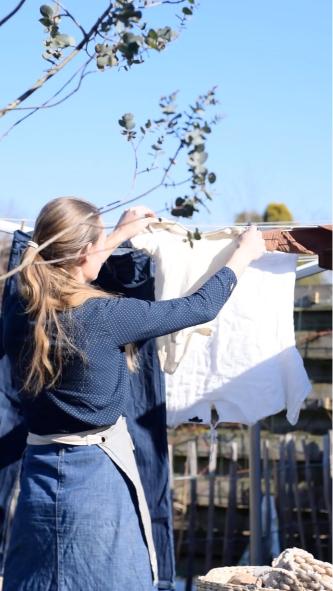
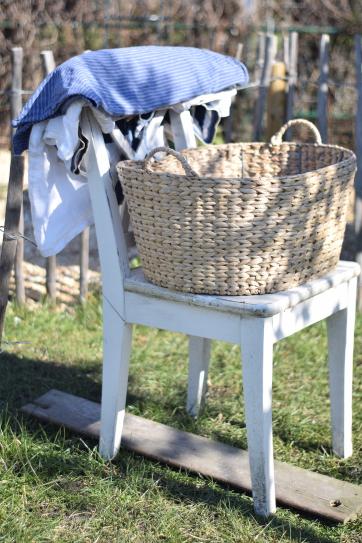
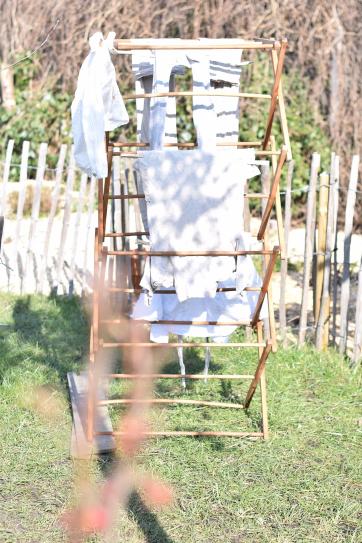
Retractable clotheslines
Retractable clotheslines are convenient when your available space is limited. It also looks pretty since you can retract the clothesline when it’s not in use.
Another advantage of a retractable clothesline is that is space-saving. There is no clothes rack to store, just a line for line drying clothes outdoors.
A Drying mill
A drying mill is another option. It’s a retractable kind of drying mill that you place in the ground. You can fold it when it’s not in use.
To install the drying mill, you need a ground spike. It usually comes with a drying mill. If there’s no ground spike included, double-check if the ground spike fits around the diameter of the drying mill’s pole.
When you do not line-dry your clothes, you can simply remove the drying mill by folding the drying mill and lifting it from the ground spike.
The drying mill has multiple lines. The ways a drying mill if set up provides lots of meters of drying line. For example, an average drying mill of 2.5 meters in diameter can have over 45 meters of drying line.
A wooden drying rack
These are my absolute favorite for use on laundry days, simply because they look so pretty.
A wooden drying rack is not only beautiful but practical as well since it can be folded and stored when not in use.
They’re also great when you have lots of smaller items like socks and underwear and you can place one near your wood stove on cold winter days.
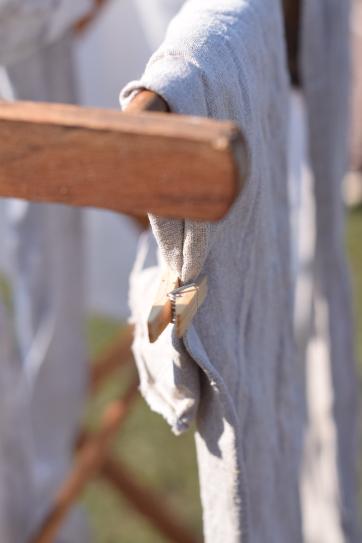
Get outdoors more…
Download your FREE Garden Planner
Other ways to dry clothing
When you have a small space to work with, it’s essential to make efficient use of the available space.
If you don’t have a garden to line dry clothes, there are other ways to dry your fresh laundry without the use of an electric dryer.
Here are some ideas of ways to line-dry your clothes without the use of a clothes dryer.
1. Indoor Drying Rack: Use an indoor drying rack or clotheshorse to air dry clothes inside your home, especially during colder or wetter weather.
2. Towel Rack: Hang smaller items like socks and underwear on a towel rack in your bathroom to dry after washing.
3. Shower Curtain Rod: Utilize the curtain rod in your shower to hang damp clothes and allow them to air dry.
4. Balcony or Patio: If you have outdoor space like a balcony or patio, set up a clothesline using (coated!) ropes or a retractable drying rack.
5. Over Furniture: Drape clothes over the backs of chairs, sofas, or other furniture items indoors to let them air dry. Do make sure the clothes aren’t too wet.
6. DIY Hanging System: You can get creative with DIY solutions like hanging clothes from a tension rod between two walls or using hangers attached to hooks on the ceiling.
7. Heat Source: During colder months, place your clothes on or near a radiator or wood stove to benefit from the warmth.
8. Clothes Horse: Invest in a collapsible clothes horse or drying rack that can be set up indoors or outdoors as needed.
9. Fence or Railing: Hang clothes over a fence or railing in your yard if you don’t have a traditional clothesline available
10. Laundry Room: Utilize wall-mounted drying racks or designated hooks in your laundry room to air dry clothes efficiently
11. Basement: If you have a basement, you could set up a drying area with clotheslines or drying racks for air-drying your clothes
12. Attic: Hang clothes in your attic space during dry weather conditions to take advantage of the warm, dry environment for drying. Above the stairs is also great because the upward heat helps to dry your clothes.
13. Garage: Make use of the space in your garage by setting up a clothesline or drying rack for air-drying clothes, especially if it’s well-ventilated
14. Spare Room: Transform a spare room into a temporary drying space by setting up multiple drying racks or lines for larger loads of laundry
15. Veranda or Porch: If you have a covered veranda or porch, utilize the space for air-drying clothes, protecting them from direct sunlight and rain.
16. Coat Hangers: Hang clothes on coat hangers and place them on a shower rod, curtain rod, or any other suitable hanging space indoors.
17. Window Sills: Use window sills as drying racks for smaller items like socks, underwear, and hand towels that benefit from exposure to sunlight and airflow.
18. DIY Drying System: You could bring in your children and build a wooden drying rack together or, repurpose a thrifted ladder.
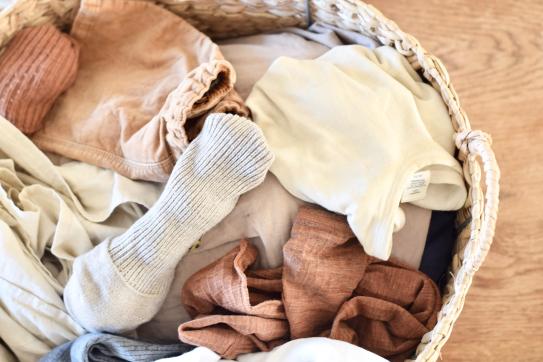
The drying process
When you take your fresh laundry from the washing machine, the excess moisture is drained at the last spin cycle of your washing machine. For your clothes to fully dry, the additional moisture needs to evaporate.
Because of the wind and/ or warmth in the environment, the clothes dry because the water molecules evaporate.
As simple as this may sound, it means that you can have a sunny day, with a high humidity, and your clothes still won’t dry. On the other hand, it can mean that on a cold, windy winter day, you may be able to take your freeze-dried clothes off the clothesline at the end of the day; fully dried.
So, it’s important to understand the best weather conditions for your clothes to dry in. Check the weather forecast or one of the weather apps if you have a smartphone and check for the relative humidity.
Generally, the higher the humidity, the longer the drying time. High heat, dry air, and a bit of wind will decrease the drying time significantly.
Tips for successful line drying your clothes
Especially if you plan to build a permanent clothing line to line-dry clothes, carefully take into consideration the location of the clothes line.
It’s best if the clothing line is placed where there is a bit of wind. The fresh air helps to dry the clothes faster. However, the wind speed should not be so high that it becomes inconvenient and your clothes fly to your neighbor when one of your clothes pins fails.
You can reduce the drying time for delicate items, such as wool and silk, which use a low spin cycle on the washing machine, by rolling the garment in a dry towel to squeeze out any excess moisture.
Place white clothing, cloth diapers, etc. in direct sunlight to remove stains. It’s not advisable to line dry lightly colored wool garments under direct sunlight as they may turn yellow. A light breeze will freshen up wool garments.
Add plain white vinegar to your washing machine’s rinse cycle compartment to soften towels.


